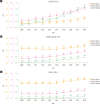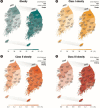Obesity Fact Sheet in Korea, 2020: Prevalence of Obesity by Obesity Class from 2009 to 2018
- PMID: 34158420
- PMCID: PMC8277583
- DOI: 10.7570/jomes21056
Obesity Fact Sheet in Korea, 2020: Prevalence of Obesity by Obesity Class from 2009 to 2018
Abstract
Background: We examined the prevalence of different obesity classes in South Korea based on the 2020 Obesity Fact Sheet.
Methods: Individuals ≥20 years who underwent a health examination provided by the Korean National Health Insurance System between 2009 and 2018 were included and the prevalence of class I, II, and III obesity was calculated for the total sample and age, sex, and region subgroups.
Results: From 2009 to 2018, the prevalence of all obesity classes increased across all sex and age groups and all regions. In the study population as a whole, the prevalence of class I, II, and III obesity was 29.1%, 3.2%, and 0.3% in 2009 and 32.5%, 5.2%, and 0.81% in 2018, respectively. Among young-aged individuals, the prevalence of each obesity class was 23.7%, 3.6%, and 0.44% in 2009 and 28.3%, 6.9%, and 1.61% in 2018, respectively. The prevalence among middle-aged individuals was 31.6%, 3.1%, and 0.24% in 2009 and 33.6%, 4.8%, and 0.59% in 2018; and among elderly individuals was 31.9%, 3.1%, and 0.21% in 2009 and 35.5%, 3.9%, and 0.32% in 2018. The increase in the prevalence of all obesity classes among young adults was dramatic. In particular, the class III obesity prevalence increased up to 3.8- and 3.5-fold between 2009 and 2018 in young men and women.
Conclusion: Based on the 2020 Obesity Fact Sheet, there was a dramatic increase in the prevalence of class II and III obesity from 2009 to 2018 among young adults, as well as the population as a whole. Optimal strategies for the prevention and treatment of obesity are needed considering the recent obesity epidemic in South Korea.
Keywords: Fact sheet; National Health Insurance System; Obesity; Obesity class; Prevalence.
Conflict of interest statement
Eun-Jung Rhee has worked as an Editor-in-Chief of the journal since 2021. And, Ga Eun Nam has worked as an Associate Editor of the journal since 2020. However, they were not involved in the peer reviewer selection, evaluation, or decision process of this article. Otherwise, no other potential conflicts of interest relevant to this article were reported.
Figures




References
LinkOut - more resources
Full Text Sources
Medical

